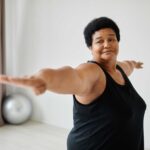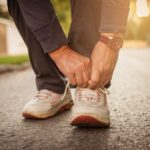
13 Apr What’s Your Fall Risk? Assess it Here
Falls are much more common than most people think, and they become even more common as we age. Over 30% of people over 65 years old will report a fall every year. Sadly, medical experts suspect the majority of people who fall don’t report it either due to embarrassment or fear of losing their independence if they tell someone. Falls do have an enormous impact on our ability to maintain our independence as we age. Up to 30% of the falls sustained each year lead to a serious injury such as head trauma or a fracture, 90% of all hip fractures occur as a result of a fall, which directly impacts the overall health and well-being specifically in older individuals. Only 30% of the people who fall and sustain a serious injury such as head trauma or fracture will return to their previous level of function; that means 70% don’t, which can lead to a downward spiral for mobility, physical activity, and daily independence.
Some of the reasons for an increased fall risk in the aging population are due to the aging process. Balance and fall risk are affected by a number of interacting factors which often decline as we age. Systems affecting fall risk:
- Our sensory system: includes what we feel with our feet while we are standing and walking.
- Our muscular system: includes our lower body strength for standing-up, walking, and catching our balance if we do trip.
- Our cognitive system: helps us properly process information in our environment.
These all interact to help us maintain our balance and function in our daily lives. Some of these systems are affected by aging or by chronic diseases, diabetes and heart disease, which are also associated with aging.
Even though there are a number of factors associated with falling, there are ways for us to self-assess or identify if someone we care for is at risk for a fall. We will discuss how a physical therapist or other medical professionals can be involved in this process in Part 3 of this series, but for now each of us can look at a few factors. Here are a few general guidelines to check yourself or a loved one for fall risk:
1. First, can you or the person you are concerned about stand on one leg without touching anything for balance for at least 10 seconds? Be sure to do this in a safe environment, but if you are not able to do this you have an increased fall risk.
2. Secondly, if you have noticed an increase in the number of “near falls” (ie. stumbling or tripping) while walking, or you feel like you need to cruise along furniture or touch walls while walking or you can’t walk without the use of a cane, you are at risk for a more serious fall.
3. Another risk factor is the speed you are able to safely walk and move around. If you or your loved one is not able to keep up with others or you feel like you need to “hold on” while walking, further assessment is likely necessary.
4. Finally, if it’s difficult to walk and talk or you have to look at the floor while walking, you may need to have a medical professional fully assess your fall risk or help identify ways you can improve your balance and mobility.
*Remember, many of these changes occur slowly over time, so it may be difficult to notice them in ourselves. Ask other people to give you feedback and be on the lookout for risk factors in those close to you.
Even though some deficits in these areas are common as we age, there are a number of things that can be done to reduce these deficits or eliminate the impact they may have on our independence. We will further address these areas and what can be done to reduce your fall risk in Parts 2 and 3 of this series. We’ll share those coming up! If you believe you’ve identified fall risks in yourself or a loved one, Body One Physical Therapy is here to help. We’re locally-owned and operated, with three locations serving Central Indianapolis: North Meridian/Carmel, Fishers, and Zionsville. Schedule a visit with one of our caring, expert Physical Therapists with a call or click!





